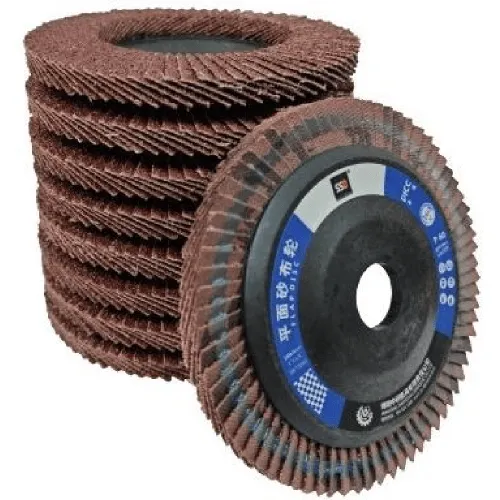What Makes Flap Discs Unique in Abrasive Technology
Multi-Layered Flap Design for Consistent Performance
What makes flap discs so special in the world of abrasives is their layered construction. Compared to regular grinding wheels, these discs remove material much faster because of how they're built. The way they wear down over time keeps them performing consistently from start to finish. Each layer of abrasive material wears at different rates, so the cutting edges stay sharp longer. Fabrication shops love this because it means longer tool life and better surface finishes right off the machine. Less time spent on extra work like sanding or polishing translates to real savings on the shop floor. For anyone working with metals regularly, flap discs just make sense when looking to boost both production speed and end results without compromising quality.
Heat Dissipation Mechanisms in Flap Discs
Flap discs stand out because they handle heat so well while working, which really helps them last longer and keeps the material being worked on safe from damage. Their layered design actually improves air flow around the disc, helping it stay cool instead of getting too hot like regular grinding tools often do. When things get too warm, standard abrasives tend to fail early, but flap discs avoid this problem. Good heat control means neither the disc nor what's being worked on gets warped or discolored. Looking at how these discs perform under stress, it becomes clear why many professionals prefer them when dealing with jobs that generate lots of heat. The way they manage temperature makes all the difference in tough cutting situations.
Material Science Behind Flap Disc Construction
Ceramic vs. Zirconia Abrasive Grains
Knowing how flap discs are built at the material level really makes a difference in how they perform, especially when deciding between ceramic versus zirconia abrasives. Ceramic grains last longer and handle tough jobs well, which is why they work great on metals where things get intense. Bell over at PFERD backs this up, saying ceramic is top pick for working with stainless steel parts. Zirconia isn't quite as tough but cuts faster and harder, so these tend to work better on softer stuff like wood or plastic. The difference matters a lot since picking the right grain type determines how long the disc lasts and how effective it will be in real world situations. Most shops go for ceramic in high stress environments because they just hold up better against all that grinding and friction.
Backing Plate Materials and Durability
The backing plate on a flap disc really matters when it comes to how long the tool lasts and performs at high speeds. Most backing plates are made from either fiberglass or aluminum, though many manufacturers go with fiberglass because it's lighter and bends better under stress. Research shows stronger backing plates actually hold up the whole disc structure better, cutting down on breakdowns after lots of use. The good news is these materials stand up to tough jobs without wearing out too fast, something anyone who works with abrasive tools knows is important for keeping things running smoothly. Frank Prenda at Gemtex Abrasives points out that newer options like trimmable plastic backing give discs a lower profile while making them last longer, especially useful for those really rough applications. Picking the right material for the backing plate isn't just about specs on paper it actually affects how well and how cheaply abrasive work gets done day after day.

Optimizing Flap Disc Performance Through Geometry
Type 27 (Flat) vs Type 29 (Conical) Profiles
When it comes to picking between Type 27 and Type 29 flap discs, getting this right makes all the difference in how well they perform. Type 27s work best on flat areas because they maintain good contact across the surface, which leads to smoother finishes overall. These are great choices for jobs like finishing touches or blending metal when someone needs to work at angles ranging from straight on up to about 15 degrees according to Hanna's research. On the flip side, Type 29 conical discs were made with edges and contours in mind. They come with a built angle that lets workers tackle curved or uneven surfaces much more aggressively, so they're really handy when there's lots of material to remove quickly. Picking one over the other affects not just how comfortable operators feel during long sessions but also how effective the whole operation ends up being across different industries where these tools get used regularly. Knowing what each type does best helps shops match their equipment to specific job demands and achieve better results without unnecessary hassle.
Radial vs Standard Flap Arrangements
The way flaps are arranged makes all the difference when it comes to how well grinding operations adapt and perform. Radial arrangements give users more flexibility and better precision while working, which is why they're so popular for jobs that need really fine finishes. The flaps themselves bend around surfaces easily, letting operators handle a wide range of projects without much hassle. Standard arrangements take a different approach altogether. They remove material at a steady rate across the whole surface, which works great when speed matters more than intricate detailing. Many shops find this setup ideal for repetitive grinding tasks where getting consistent results fast is what counts most. Knowing when to pick radial versus standard configurations isn't just about theory it's about matching tools to actual job requirements so the flap discs actually do their best work in real world conditions.
Industrial Applications of Advanced Flap Disc Technology
Welding and Metal Fabrication Uses
Flap discs are changing how welders and metal fabricators approach their work when it comes to removing rust and getting surfaces ready for coating. These discs handle everything from steel to stainless materials, so they work great for those tough jobs that come up regularly in workshops. What really stands out is that one disc does both grinding and finishing at once, something that used to require switching between different tools all day long. Shops report noticeable gains in what gets done each shift because there's less downtime swapping equipment around. Plus, workers appreciate not having to reach for another tool every few minutes, which cuts down on fatigue during long projects. The money saved from buying fewer specialized tools plus better worker comfort makes these discs worth considering for anyone doing serious welding work.
Surface Preparation in Automotive Manufacturing
Flap discs are becoming essential for surface prep work across the automotive industry, helping ensure good paint adhesion and smooth finishes on vehicles. Compared to old school sanding techniques, these tools cut down on both time spent and money wasted on labor costs. Auto makers are increasingly turning to flap discs these days, which speaks volumes about how important they've become for maintaining quality standards during production. Looking at recent data from the market, it's clear why this shift is happening so fast – flap discs consistently produce great results while saving valuable shop time. With shops always looking for ways to get things done faster without sacrificing quality, it's no surprise that many mechanics and plant managers now consider flap discs their go-to solution for all sorts of grinding and polishing tasks in car manufacturing.
Market Trends in Flap Disc Technology
Growth Projections: 11.7% CAGR (2025â2032)
The flap disc market looks set to grow at a pretty healthy clip, around 11.7% compound annual growth rate from 2025 through 2032 according to projections. Construction sites and auto repair shops are driving much of this demand since workers rely heavily on flap discs for all sorts of sanding and polishing tasks across different materials. Tech improvements have also played a big role lately. Manufacturers keep coming out with better products that last longer and work across more applications than before. These upgrades help companies tackle tougher jobs while saving money on replacements. As industries continue changing their requirements, tool makers adapt fast to stay competitive in what's becoming quite a dynamic marketplace.
Regional Adoption in Aerospace and Construction
Flap discs have become really popular in aerospace manufacturing lately because companies need super precise cuts and want to remove materials efficiently without damaging delicate components. Construction workers also love using flap discs for their surface prep jobs since they save time on site and get better results than traditional methods. While there are differences in how different countries regulate tool usage and what specs each region requires, most market reports still show growing demand for flap discs worldwide. What makes these tools stand out is their ability to handle various surfaces while maintaining productivity levels, which explains why so many shops in both fields keep switching to flap discs despite other options being available.
Innovations Driving Flap Disc Evolution
Trimmable Backing Systems for Extended Use
The introduction of trimmable backing systems in flap discs has made them much more versatile and effective for various industrial jobs. Workers can now cut down the disc size according to what they need for each particular task, which cuts down on material waste and makes operations run smoother. What's really great about this is that it extends how long the discs last before needing replacement, saving companies money over time. Many manufacturing plants report cutting their replacement costs by around 30% after switching to these adjustable systems. Because of this flexibility, most forward-thinking companies now look for trimmable options when buying new grinding equipment for their workshops.
Hybrid Discs Combining Multiple Abrasive Types
Hybrid discs represent something new in flap disc tech since they mix several different abrasive materials together. What happens is these discs take advantage of what works best from each type of abrasive material, which means better results across a wider range of jobs. The real value becomes apparent when working on tricky projects like building composite parts or doing metalwork that involves handling multiple materials at once. According to some folks who know their stuff in the field, these hybrid options actually cut down on time spent on tasks while delivering smoother surfaces too. For anyone involved in fabrication work, getting hold of these discs can make all sorts of difference in both quality and efficiency.
FAQ Section
What are the key benefits of using flap discs?
Flap discs offer improved material removal, consistent performance throughout their lifespan, heat dissipation, and enhanced surface finishes, reducing the need for secondary operations like sanding or polishing.
How do ceramic and zirconia abrasive grains differ in flap discs?
Ceramic abrasive grains are more durable and better for heavy-duty applications, especially on metal substrates. Zirconia grains, while slightly less durable, provide higher aggression and cut rates for softer materials.
What are the advantages of trimmable backing systems in flap discs?
Trimmable backing systems allow users to adjust disc size, minimizing waste and extending disc lifespan, leading to cost savings and enhanced operational efficiency.
How do Type 27 and Type 29 flap disc profiles differ?
Type 27 flap discs are ideal for flat surfaces and smooth finishes, while Type 29 conical discs are designed for edge and contour work, offering more aggressive grinding on rounded or irregular surfaces.
Where are flap discs commonly used in industrial applications?
Flap discs are widely used in welding, metal fabrication, automotive manufacturing for surface preparation, aerospace, and construction industries due to their efficiency and adaptability.


